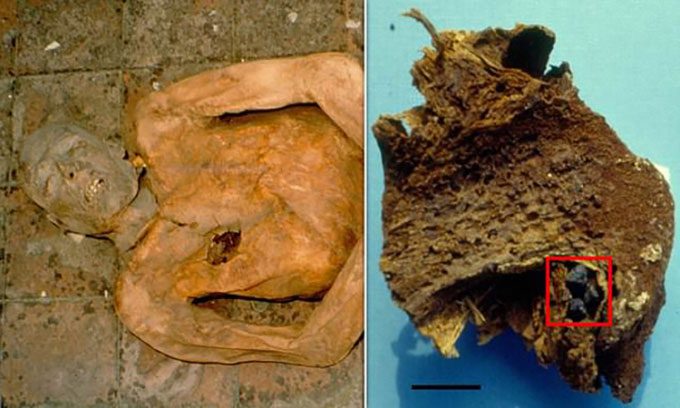Experts Isolate E. coli Samples from the Gallbladder of a Nobleman Who Died in 1586 and Successfully Reconstruct an Ancient Gene Set of the Bacteria.
A research team from McMaster University and Paris Cité University has identified and reconstructed the first ancient gene set of the bacterium Escherichia coli (E. coli) from a 16th-century Italian mummy. The new study was published in the journal Communications Biology on June 16.

The mummy of an Italian nobleman (left), liver and gallbladder of Giovani d’Avalos (right). The gallstones containing E. coli samples are highlighted in red. (Photo: George Long/ University of Pisa)
Today, E. coli remains a public health concern and can lead to fatalities. This bacterium is commonly found in the intestines, where it is usually harmless and helps maintain a healthy digestive system. However, some strains of E. coli can severely affect human health, causing diarrhea, pneumonia, respiratory diseases, and other illnesses. It is also an opportunistic pathogen that can infect hosts with weakened immune systems, stress, or underlying health conditions.
Experts still do not fully understand the evolutionary history of E. coli. They believe that this bacterium has a significant impact on human health, yet there is limited historical documentation on the subject, unlike diseases such as the Black Death, which killed approximately 200 million people worldwide.
In the new study, the team utilized the mummy of an Italian noble family. These mummies were discovered at the Saint Domenico Maggiore monastery in Naples in 1983. The researchers focused on Giovani d’Avalos, a nobleman who died in 1586 at the age of 48. They suspect he suffered from chronic cholecystitis due to gallstones.
The scientists isolated bacterial samples from d’Avalos’s gallstones and reconstructed the E. coli gene set. This 400-year-old “ancestor” of E. coli may help scientists make direct comparisons to analyze how this bacterium has adapted and evolved over time.
“When we examined the mummy, there was no evidence that this individual was infected with E. coli. Unlike diseases such as smallpox, there were no clear physiological signs,” explained George Long, a co-author of the study. The new research is a technical achievement, as E. coli is highly complex and can survive in both soil and the human microbiome.
“It is fascinating to be able to classify this ancient E. coli and discover that, despite being unique, it still belongs to the phylogenetic lineage that today causes gallstones in humans,” said Erick Denamur, a member of the research team.
“We can identify where the opportunistic pathogen lies, understand the functions of the gene set, and provide guidance to support scientists studying other potential pathogens,” Long added. Additionally, the new research helps experts gain further insights into the consequences of E. coli infections in ancient times.


















































